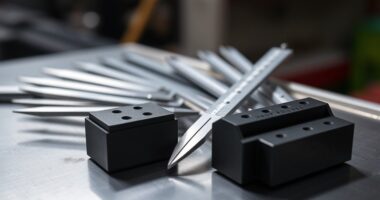When measuring moisture, you need to distinguish between relative humidity and wood moisture content. Relative humidity indicates the moisture level in the air, measured with hygrometers, helping you control environments like storage or greenhouses. Wood moisture content measures how much water is inside the wood, using moisture meters for construction or woodworking. Understanding these differences guarantees you select the right tools and techniques—keep going to learn how to get accurate readings for each.
Key Takeaways
- Relative humidity measures air moisture content, indicating environmental conditions affecting wood and other materials.
- Wood moisture content quantifies the percentage of water in wood, essential for assessing its suitability and stability.
- Hygrometers are used to measure relative humidity, while moisture meters specifically assess wood moisture levels.
- Both measurements require calibration for accuracy to prevent errors in environmental control or material assessment.
- Understanding the difference helps select appropriate tools and interpret moisture data for construction, storage, or processing.

Have you ever wondered how to accurately determine the moisture content in materials or environments? Knowing the precise moisture level is essential for a variety of industries, from construction to food production. To achieve accurate measurements, you need reliable tools calibration, ensuring your moisture meters or hygrometers provide correct readings. Proper calibration minimizes errors caused by temperature fluctuations or device drift, giving you confidence in your results. Understanding the moisture content in different contexts is key—whether you’re assessing wood for construction or monitoring humidity levels in a storage environment. Regularly checking your equipment against standard references maintains measurement accuracy over time. When measuring moisture in a solid material like wood, the process often involves using a moisture meter that penetrates the wood’s surface to give a percentage reading. The moisture content determines the wood’s suitability for projects, as too much moisture can lead to warping or decay, while too little can cause cracking or splitting. To get accurate readings, you need to ensure your tools are correctly calibrated according to the manufacturer’s specifications. Regular calibration checks, using standard references or calibration blocks, are crucial. This process helps you catch any deviations that might lead to inaccurate moisture readings, especially when measuring different types of wood or other porous materials.
On the other hand, measuring relative humidity involves assessing the moisture level in the air rather than within a solid material. Hygrometers are commonly used for this purpose, and they too require proper tools calibration. When your hygrometer is accurately calibrated, it provides reliable readings of the environment’s humidity, which is vital for maintaining optimal conditions in storage rooms, laboratories, or greenhouses. If your device isn’t calibrated, you might misjudge the environment’s humidity, leading to improper storage conditions or mold growth. Regular calibration against a known standard ensures your readings stay precise, helping you make better decisions about controlling environmental conditions.
In both cases—measuring moisture content in materials or the relative humidity in the air—accuracy hinges on properly calibrated tools. Without this, you risk making decisions based on faulty data, which can have costly or damaging consequences. Whether you’re drying wood, storing sensitive products, or monitoring indoor climate, understanding the importance of tools calibration and precise measurement techniques keeps you in control. Ultimately, mastering how to measure moisture accurately enables you to protect your materials, optimize conditions, and prevent problems caused by moisture-related issues.
Frequently Asked Questions
How Often Should I Check Moisture Levels in My Home?
You should check moisture levels in your home at least once a month to maintain proper humidity control and moisture balance. During seasonal changes or if you notice signs of excess humidity or dryness, increase the frequency. Regular monitoring helps prevent issues like mold, warping, or cracking. Use a hygrometer to track relative humidity and a moisture meter for wood, ensuring your home stays comfortable and well-maintained year-round.
Can Environmental Factors Affect Moisture Readings?
Environmental fluctuations can definitely affect your moisture readings. Changes in temperature and humidity influence the accuracy of your humidity sensors, leading to skewed results. You might worry about inconsistent data, but regularly calibrating your sensors and measuring at consistent times helps guarantee reliable readings. Keep in mind, understanding how environmental factors impact your measurements helps you better manage your home’s moisture levels and maintain a healthy environment.
What Tools Are Best for Measuring Indoor Humidity?
You should use a hygrometer to measure indoor humidity accurately. Digital hygrometers are user-friendly, often offering precise readings and easy calibration, making them ideal for consistent measurements. Analog hygrometers are reliable too but may require more frequent calibration checks to maintain accuracy. Always verify your hygrometer is properly calibrated, especially if you notice inconsistent readings, so you can monitor indoor humidity effectively and prevent moisture issues.
How Does Moisture Impact Wood Longevity?
Moisture notably impacts wood longevity by promoting wood decay and mold growth. When moisture levels are high, wood becomes vulnerable to fungi that cause decay, weakening its structure over time. Mold thrives in damp conditions, leading to health issues and further deterioration. To protect your wood, keep humidity levels balanced and ensure proper ventilation, preventing moisture buildup and extending the lifespan of your wooden structures.
Is There a Recommended Moisture Level for Different Wood Types?
Think of moisture guidelines as your friendly guide for different wood types. For most, keeping moisture levels around 6-12% works well, ensuring durability and beauty. Softwoods like pine prefer a slightly higher range, around 8-15%. Hardwoods like oak do best at 6-12%. Always consider your specific wood type’s needs, and stay within these ranges to help your wood stay strong and beautiful over time.
Conclusion
Understanding the difference between relative humidity and wood moisture is like finding the key to a healthy, stable environment. By mastering these measurements, you hold the power to protect your wood and your space from damage. Think of it as tending a delicate garden—you must nurture it carefully. When you keep moisture levels in check, your wood stays strong and beautiful, standing tall against the storms of time. Your knowledge is the anchor that keeps everything steady.









